by Tom Gaylord
Writing as B.B. Pelletier
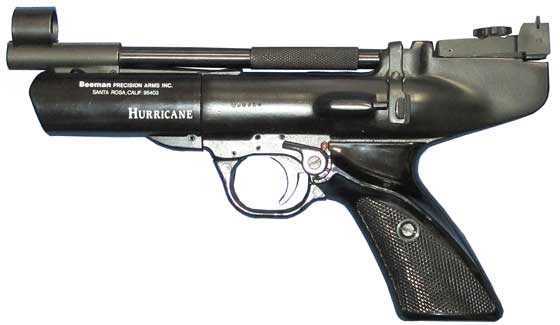
Webley Hurricane.
by Tom Gaylord Writing as B.B. Pelletier 03-23-20-01-Hurricane Webley Hurricane A history of airguns This report covers: History The Webley Premier Webley Junior Premier Mark II changes to Hurricane Webley Premier Mark III Quick fix? The Hurricane So? Webley Tempest There is more… Back to the Hurricane Cocking What to expect Summary Today I begin a report that I thought I had already written. But when I looked in the archive I find that I have never reported on this pistol in the traditional way. I have included it in other reports and I have referred to it many times but I have never done a full report on the Webley Hurricane. History Because of my oversight I have decided to spend additional time covering part of the history of Webley air pistols and the things that lead up to the Hurricane. This will be from my perspective, because there are probably several different stories about how the Hurricane came to be. The Webley Premier In 1964 Webley replaced the Mark I and Senior pistols with the new Premier. It was an all-steel pistol that had the same build quality as the models it replaced. The bluing was up to Webley standards, which is to say very good. In all respects that first Premier was a high quality air pistol. But changes were coming. This was a time when costs were being examined carefully, to see where savings could be found — and what the market would tolerate along those lines. The Premier replaced two pistols with one, which was a savings of many small parts. It also streamlined the Webley pistol line, because when you sell just one thing instead of two, specialized associated items like boxes and manuals are reduced, not to mention many small parts. For instance you no longer need two sets of grips — just the set that fits the new pistol. 03-23-20-02-Premier-catalog From first Beeman catalog that was published in 1974, the Webley Premier was all-steel and blued. Webley Junior Webley also had a Junior pistol in their lineup at this same time, and over the next 12 years they made subtle changes in the construction of that pistol. The most dramatic change was when they switched from a steel frame to one made from aluminum — or aluminium as the UK calls it. It was just as good a material as steel from a performance standpoint, but enthusiasts noticed the change right away. The black epoxy resin paint that replaced the blued steel certainly did nothing to hide the change! When I came on board as a semi-serious airgunner in 1976 these changes were starting to invade the marketplace, so I had a front-row seat for all that transpired. Ironically I was living in Erlangen, Germany, at the time. Erlangen was the home of BSF airguns, a fact I didn’t discover until about 15-20 years after returning to the US and leaving the Army! Yes, there I was in my quarters in Erlangen, pouring over the first edition of Airgun Digest and lamenting a situation that was out of my control (living in Germany, where Beeman airguns were not available), all the while I was stumbling past the plant that produced some of the finest airguns I never heard of! I’m in the middle of the strawberry patch, complaining that they aren’t cherries! That makes today’s report my penance. The Webley Junior Mark II and the Premier Mark II I returned to the US in 1977 and promptly visited the Beeman company in Santa Rosa. I picked up their catalog and also an FWB 124 that was the hottest pellet rifle in existence, according to Robert Beeman. Years later when I started writing about airguns and began learning about them I discovered that the HW35, The Diana 45 and the BSF S55/60/70 were all in contention for the title of baddest pellet rifle in the world. In truth the HW35 was hamstrung by a short piston stroke and only merited honorable mention. The BSF S55/60/70 was hotter and gave the FWB 124 a run for the money. And, hands down, the Diana 45 was the power champion when it was tuned correctly. Nevertheless, the 124 cocked the easiest and was probably the most accurate, so it took top honors — both then and today. But, what does any of that have to do with Webley pistols? A lot, as it turns out. Because that was the environment at the time. Who was the fastest, the most powerful, the champ? To be cheapening a design at this time in airgun history was disaster because the whole (airgun) world was watching. But that is what Webley did with the Junior pistol. In 1973 they made it the Junior Mark II with an aluminum body. It functioned very well, but building it that way flew in the face of tradition! Following that, in 1975 they dropped the all-steel Premier and brought out the Premier Mark II — an aluminum body cast around a steel compression tube and finished with black epoxy paint! 03-23-20-03-Premier-MarkII The Premier Mark II had an aluminum body that was cast around a steel liner for the compression tube. See the two different diameters of the body? So did the airgunning world. Design changes usually take time to reach the market. Often the older models have to be flushed out before the changes are fully felt. It can take years to transition, and it was during this same time that I returned to the US as a budding airgunner. Premier Mark II changes to Hurricane In 1977, just two years after it was launched, the Premier Mark II was discontinued and was replaced by the Webley Hurricane. Now, that is our subject airgun today, but the history lesson is not over yet. Webley Premier Mark III What you may not know is in 1974 Webley built a prototype pistol that had a white nylon body. They called it the Premier Mark III, but wise heads at Webley figured that if the public didn’t like the aluminum Mark II they would hate one made out of plastic. Duh! They then changed the name to Superpremier, but like Coke discovered several years later, the name alone won’t save a faulty idea. Yes — Webley was considering making a plastic air pistol! They retained the shape of the plastic pistol, but made the new air pistol out of aluminum and called it the Hurricane. 03-23-20-04-Hurricane The first announcement of the Webley Hurricane in the Beeman catalog. Notice there are not two diameters of the body? Quick fix? The speed with which the Hurricane replaced the Premier Mark II suggests the Premier Mark II had not met with a warm reception. I was there to watch and that is exactly what happened. The two-diameter tube was a big point of contention, so the Hurricane had a plastic sleeve over the smaller part of the tube to smooth out the look. The Hurricane The Hurricane was still painted with black epoxy, but its grip is quite different and the back of the frame comes back much farther, making an overhang over the grip. The rear sight comes way back to the end of the overhang, giving the pistol a greater sight radius. Webley also included a plastic adaptor to fit a scope to the pistol in place of the rear sight — not that I ever would! If you look you will see that the Premier Mark II has the suggestion of the sculpted grip shape, but the shape of the Hurricane grip is exaggerated. And the Hurricane grip has a thumbrest on the left side The Hurricane front sight is hooded and, if you remove the hood, the sight blade you’ll find underneath is taller than that of the Premier or Premier Mark II front sight. The rear sight is also larger and more refined. It adjusts in both directions with precision clicks, where the sights on the Premier and Premier Mark II move more crudely by loosening the screws and sliding the sight pieces. 03-23-20-06-Hurricane-rear-sight The Hurricane rear sight has precise click adjustments and a crisp notch. So? So, the Hurricane is more than a simple re-skin of the Premier Mark II. It is a completely different and more sophisticated air pistol. And what I am about to tell you will probably come as a surprise to many of you because it sure did to me! Webley Tempest In 1979, two years after the Hurricane came to market, Webley brought out the Tempest — a pistol I have always thought came before the Hurricane. When you look at it you will see the lines of the Premier Mark II, with some of the Hurricane advancements like the grips and the plastic body shroud thrown in. 03-23-20-05-Tempest See how the Tempest carries forward the lines of the Premier Mark II while incorporating some of the features of the Hurricane? The Tempest rear sight reverts back to the screw and sliding parts, rather than the more advanced adjustments of the Hurricane. And the front sight blade shrinks back down to Premier Mark II height. So the Tempest is a different airgun than the Hurricane. Webley made the separation between the two models obvious. There is more… Yet the story does not end with the Tempest. Remember the Junior Mark II mentioned earlier? Webley stopped producing them in 1977. What took their place for a time was a pistol that Webley called the Typhoon. It was made from 1977 to 1982 and was a lower-powered version of the Hurricane, and yes, there were those at Webley who wanted to call it the Superjunior. Can’t get rid of employees for poor taste, alone, I guess. So, that’s some of what went on while the Hurricane was gestating at Webley. For many of my facts I credit the book, The Encyclopedia of Spring Air Pistols, by John Griffiths, copyright 2008 by Ashlea Publications. Back to the Hurricane The Webley Hurricane is a single shot breakbarrel spring piston air pistol that cocks via an overlever principal that uses the barrel as the cocking lever. The cocking sequence is the same as for all other Webley spring-piston pistols as well as several of their vintage rifles. 03-23-20-07-Hurricane-cocked Cocking the Hurricane requirtes Cocking The cocking sequence has to be learned. Once you learn it you will be able to cock all Webley spring-piston air pistols, regardless of the model or date of manufacture. Because of the way the pistol cocks, the piston comes back at your firing hand when the gun fires. It sounds like it would give the impression of recoil, but it truth the pistol just pulses in the hand without any flip of the barrel. The trigger is not adjustable. It is single stage and mine is very crisp and reasonably light. I will measure it for you in Part 2. To most airgunners a Hurricane looks large, unless they have a BSF S20 or a BSA Scorpion in their collection. It certainly looms large over most other air pistols. It’s 10-3/8-inches long when the scope mount is not attached, 5-7/8-inches high and weighs 2 lbs. 3 oz. The rifled barrel is about 7 inches long. I’ll measure the cocking effort in Part 2, but for now let’s just say it isn’t easy. You need to learn the special way to hold your hands to get the most leverage when cocking, and I have known people who simply refused to do it that way. They keep waiting for someone to show them the secret way. What to expect The Hurricane is one of those airguns around which legends have formed. It is powerful, but perhaps not as powerful as you might imagine. It’s going to shoot lighter pellets in the 450-475 f.p.s. region — just a little less than a Beeman P1. The Hurricane’s piston travels back toward the shooter when the gun fires. You might expect that to cause a realistic recoil sensation, but it actually doesn’t. The pistol just pulses each time it is fired. You know it has fired but there is no movement in your hand. The very nice sights give the impression of accuracy, but don’t be fooled. The Hurricane is a plinker — not a target pistol. You’re doing okay if you’re shooting a group of 10 under an inch from ten meters. Summary That’s a start of the report I have waited 15 years (as of March 5th) to write. This time I will cover all the bases with the Hurricane so we will know how it does. Stay tuned! A history of airguns
This report covers:
- History
- The Webley Premier
- Webley Junior
- Premier Mark II changes to Hurricane
- Webley Premier Mark III
- Quick fix?
- The Hurricane
- So?
- Webley Tempest
- There is more…
- Back to the Hurricane
- Cocking
- What to expect
- Summary
Today I begin a report that I thought I had already written. But when I looked in the archive I find that I have never reported on this pistol in the traditional way. I have included it in other reports and I have referred to it many times but I have never done a full report on the Webley Hurricane.
History
Because of my oversight I have decided to spend additional time covering part of the history of Webley air pistols and the things that lead up to the Hurricane. This will be from my perspective, because there are probably several different stories about how the Hurricane came to be.
The Webley Premier
In 1964 Webley replaced the Mark I and Senior pistols with the new Premier. It was an all-steel pistol that had the same build quality as the models it replaced. The bluing was up to Webley standards, which is to say very good. In all respects that first Premier was a high quality air pistol. But changes were coming. This was a time when costs were being examined carefully, to see where savings could be found — and what the market would tolerate along those lines.
The Premier replaced two pistols with one, which was a savings of many small parts. It also streamlined the Webley pistol line, because when you sell just one thing instead of two, specialized associated items like boxes and manuals are reduced, not to mention many small parts. For instance you no longer need two sets of grips — just the set that fits the new pistol.
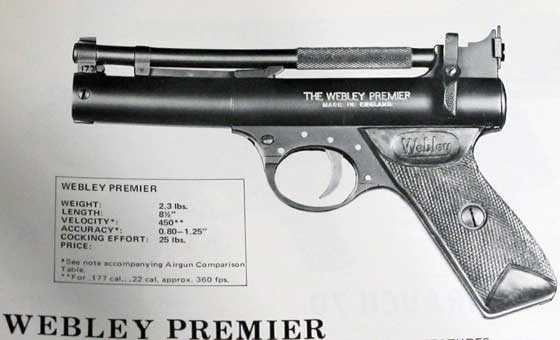
From the first Beeman catalog that was published in 1974, the Webley Premier was all-steel and blued.
Webley Junior
Webley also had a Junior pistol in their lineup at this same time, and over the next 12 years they made subtle changes in the construction of that pistol. The most dramatic change was when they switched from a steel frame to one made from aluminum — or aluminium as the UK calls it. It was just as good a material as steel from a performance standpoint, but enthusiasts noticed the change right away. The black epoxy resin paint that replaced the blued steel certainly did nothing to hide the change!
When I came on board as a semi-serious airgunner in 1976 these changes were starting to invade the marketplace, so I had a front-row seat for all that transpired. Ironically, I was living in Erlangen, Germany, at the time. Erlangen was the home of BSF airguns, a fact I didn’t discover until about 15-20 years after returning to the US and leaving the Army! Yes, there I was in my quarters in Erlangen, pouring over the first edition of Airgun Digest and lamenting a situation that was out of my control (living in Germany, where Beeman airguns were not available), all the while I was stumbling past the plant that produced some of the finest airguns I never heard of! I’m in the middle of the strawberry patch, complaining that they aren’t cherries! Today’s report is my penance for that.
The Webley Junior Mark II and the Premier Mark II
I returned to the US in 1977 and promptly visited the Beeman company in Santa Rosa. I picked up their catalog and also an FWB 124 that was the hottest pellet rifle in existence, according to Robert Beeman. Years later when I started writing about airguns and began learning about them I discovered that the HW35, The Diana 45 and the BSF S55/60/70 were all in contention for the title of baddest pellet rifle in the world. In truth the HW35 was hamstrung by a short piston stroke and only merited an honorable mention. The BSF S55/60/70 was hotter and gave the FWB 124 a run for the money. And, hands down, the Diana 45 was the power champion when it was tuned correctly. Nevertheless, the 124 cocked the easiest and was probably the most accurate, so it took top honors — both then and today.
But, what does any of that have to do with Webley pistols? A lot, as it turns out. Because that was the environment at the time. Who was the fastest, the most powerful, the champ? To be cheapening a design at this time in airgun history was disaster because the whole (airgun) world was watching. But that is what Webley did with the Junior pistol. In 1973 they made it the Junior Mark II with an aluminum body instead of steel. It functioned very well, but building it that way flew in the face of tradition! Following that, in 1975 they dropped the all-steel Premier and brought out the Premier Mark II — an aluminum body cast around a steel compression tube and finished with black epoxy paint!
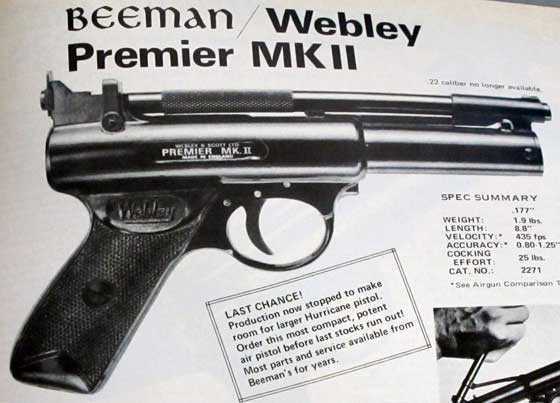
The Premier Mark II had an aluminum body that was cast around a steel liner for the compression tube. See the two different diameters of the body? So did the airgunning world.
Design changes usually take time to reach the market. Often the older models have to be flushed out of the system before the changes are fully felt. It can take years to transition, and it was during this same time that I returned to the US as a budding airgunner.
Premier Mark II changes to Hurricane
In 1977, just two years after it was launched, the Premier Mark II was discontinued and was replaced by the Webley Hurricane. Now, that is our subject airgun today, but the history lesson is not over yet.
Webley Premier Mark III
What you may not know is in 1974 Webley built a prototype pistol that had a white nylon body. They called it the Premier Mark III, but wise heads at Webley figured that if the public didn’t like the aluminum Mark II they would hate one made out of plastic. Duh! They then changed the name to Superpremier, but like Coke discovered several years later, the name alone won’t save a faulty idea. Yes — Webley was considering making a plastic air pistol! They retained the shape of the plastic pistol, but made the new air pistol out of aluminum and called it the Hurricane.
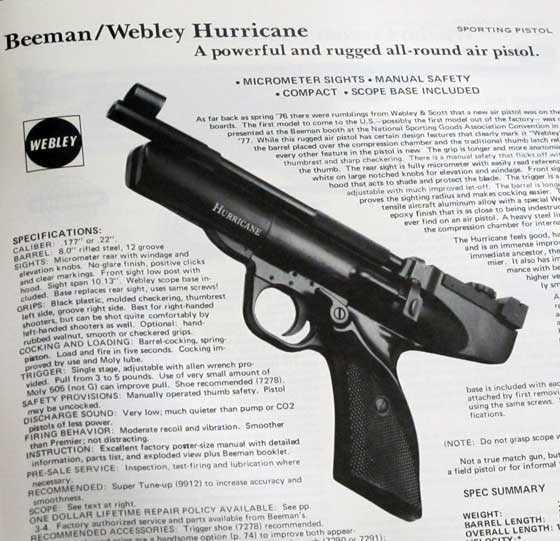
The first announcement of the Webley Hurricane in the Beeman catalog. Notice there are not two diameters of the body?
Quick fix?
The speed with which the Hurricane replaced the Premier Mark II suggests the Premier Mark II had not met with a warm reception. I was there to watch and that is exactly what happened. The two-diameter tube was a big point of contention, so the Hurricane had a plastic sleeve over the smaller part of the tube to smooth out the look.
The Hurricane
The Hurricane was still painted with black epoxy, but its grip is quite different and the back of the frame comes back much farther, hanging over the grip. The rear sight comes way back to the end of the overhang, giving the pistol a longer sight radius. Webley also included a plastic adaptor to fit a scope to the pistol in place of the rear sight — not that I ever would! If you look you will see that the Premier Mark II has the suggestion of the sculpted grip shape, but the shape of the Hurricane grip is exaggerated. And the Hurricane grip has a thumbrest on the left side
The Hurricane front sight is hooded and, if you remove the hood, the sight blade you’ll find underneath is taller than that of the sight on the Premier or Premier Mark II. The rear sight is also larger and more refined. It adjusts in both directions with precision clicks, where the sights on the Premier and Premier Mark II move more crudely by loosening the screws and sliding the sight pieces.
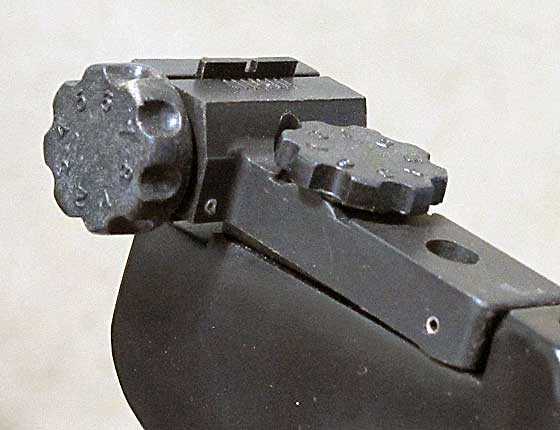
The Hurricane rear sight has precise click adjustments and a crisp notch.
So?
So, the Hurricane is more than a simple re-skin of the Premier Mark II. It is a completely different and more sophisticated air pistol. And what I am about to tell you will probably come as a surprise to many of you because it sure did to me!
Webley Tempest
In 1979, two years after the Hurricane came to market, Webley brought out the Tempest — a pistol I have always thought came before the Hurricane. When you look at it you will see the lines of the Premier Mark II, with some of the Hurricane advancements like the grips and the plastic body shroud thrown in.
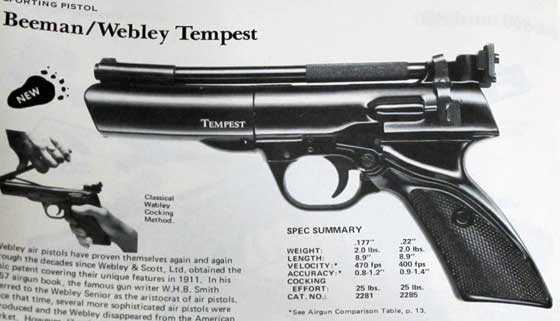
See how the Tempest carries forward the lines of the Premier Mark II while incorporating some of the features of the Hurricane?
The Tempest rear sight reverts back to the screw and sliding parts, rather than the more advanced adjustments of the Hurricane. And the front sight blade shrinks back down to Premier Mark II height. So the Tempest is a different airgun than the Hurricane. Webley made the separation between the two models obvious.
There is more…
Yet the story does not end with the Tempest. Remember the Junior Mark II mentioned earlier? Webley stopped producing them in 1977. What took their place for a time was a pistol that Webley called the Typhoon. It was made from 1977 to 1982 and was a lower-powered version of the Hurricane, and yes, there were those at Webley who wanted to call it the Superjunior. Can’t get rid of employees for poor taste, alone, I guess.
So, that’s some of what went on while the Hurricane was gestating at Webley. For many of my facts I credit the book, The Encyclopedia of Spring Air Pistols, by John Griffiths, copyright 2008 by Ashlea Publications.
Back to the Hurricane
The Webley Hurricane is a single shot breakbarrel spring piston air pistol that cocks via an overlever principal that uses the barrel as the cocking lever. The cocking sequence is the same as for all other Webley spring-piston pistols as well as several of their vintage rifles.
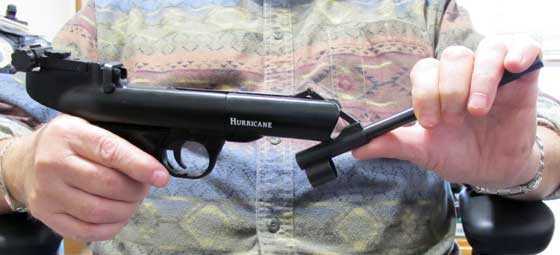
Cocking the Hurricane requires unique positioning of the hands.
Cocking
The cocking sequence has to be learned. Once you learn it you will be able to cock all Webley spring-piston air pistols, regardless of the model or date of manufacture. Because of the way the pistol cocks, the piston comes back at your firing hand when the gun fires. It sounds like it would give the impression of recoil, but it truth the pistol just pulses in the hand without any flip of the barrel.
The trigger is not adjustable. It is single stage and mine is very crisp and reasonably light. I will measure it for you in Part 2.
To most airgunners a Hurricane looks large, unless they have a BSF S20 or a BSA Scorpion in their collection. It certainly looms large over most other air pistols. It’s 10-3/8-inches long when the scope mount is not attached, 5-7/8-inches high and weighs 2 lbs. 3 oz. The rifled barrel is about 7 inches long. The Beeman catalog says it’s 8 inches, but that counts the muzzle protector that is not rifled. I only measured the tube with the twisty scratches.
I’ll measure the cocking effort for you in Part 2, but for now let’s just say it isn’t easy. You need to learn the special way to hold your hands to get the most leverage when cocking, and I have known people who simply refused to do it that way. They keep waiting for someone to show them the secret way. Well, first you get a mushroom and bury it by an old rotten log in the moonlight…
What to expect
The Hurricane is one of those airguns around which legends have formed. It is powerful, but perhaps not as powerful as you might imagine. It’s going to shoot lighter pellets in the 450-475 f.p.s. region — just a little less than a Beeman P1.
The Hurricane’s piston travels back toward the shooter when the gun fires. You might expect that to cause a realistic recoil sensation, but it actually doesn’t. The pistol just pulses each time it is fired. You know it has fired but there is no movement in your hand.
The very nice sights give the impression of accuracy, but don’t be fooled. The Hurricane is a plinker — not a target pistol. You’re doing okay if you’re putting a group of 10 under an inch from ten meters.
Summary
That’s a start of the report I have waited 15 years (as of this past March 5th) to write. This time I will cover all the bases with the Hurricane so we will know how it does. Stay tuned!

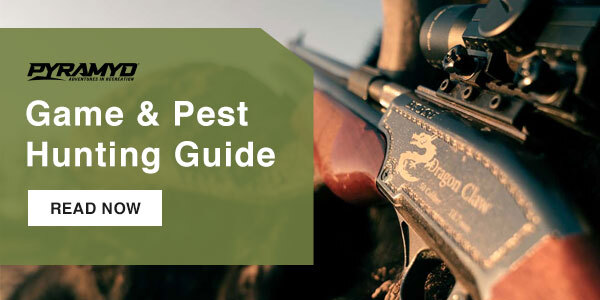
B.B.
The Tempest looks like something the engineers made up if they suddenly found a hidden cache of old Webley Premier parts. I cannot think of any other reason why they would complicate their manufacturing job after simplifying it.
Siraniko
PS: Section Webley Premier Mark III Illustration description: “Notice there are not (now) two diameters of the body?”
Section What to expect second paragraph practically repeats the latter half of the first paragraph of the Section Cocking.
Siraniko,
Both of those were intentional. I agree that adding now after not in the caption makes it read better, but I left the other as it is. It’s sort of a summary of the report.
Thanks,
B.B.
Siraniko,
B.B. will know more about it, but I thought I had read (although I just search and cannot find the article) that back when the Hurricane came out, Robert Beeman pressed Webley for a more compact version,
*shrugs*
I look forward to the accuracy test section of this report, as this gun has a much longer sight radius than the Tempest and better sights; the ones on the Tempest are “fiddly,” but they are fine once dialed in, and or sure, the Tempest was used as the basis for one of the most bizarre contraptions I’ve ever seen, “Webley Tempest adapted for use as greyhound ear tagger” (scroll down about 3/4ths of the way):
https://forum.vintageairgunsgallery.com/webley-pistols/webley-tempest/
Take care & stay safe,
dave
Dave,
Beeman may have said something but Webley always intended to build something like the Tempest, I think. The Hurricane just gave them more good ideas to fix the Premier Mark II that was poorly received.
B.B.
Thanks, B.B.; I knew you’d keep me on the straight and narrow on that! =>
I just did a search; it turns out the article I was looking for was a report written by you back in 2005!
/blog/2005/11/webley-tempest-hurricane-whats-the-difference/
And further, I was mis-remembering what you said in that report, which was “Robert Beeman made a star of the Tempest,” not that he had requested Webley to make such an air pistol; that’s a big difference; I stand corrected!
Dave,
Well, at least you found it! I could not remember writing it.
B.B.
Good one! =>
BB,
The Webleys are my favorite air pistols. No, they are not Olympians. Feral soda cans fear them though.
When but a wee bairn I had a post war Webley Mk 1. It disappeared into the mists of time. Some years ago I had an UK Tempest and foolishly let it leave The Home. Now there is a pre war Senior living here with a Service Mk II. They are going nowhere. Should another Webley find its way to RRHFWA it will be a permanent resident also.
Webleys are an acquired taste. Firing one harkens back to the time of the birth of the sproingers. The basic design of these air pistols have not changed in almost one hundred years.
RidgeRunner,
I’m with you on that; a Beeman Webley Tempest was my first air pistol. No, it wasn’t super accurate, but as you noted, it was great on feral cans. =>
I sold it to buy…I can’t remember what…but fortunately, my Dad had seen and shot mine and asked me to get him one as a tackle box gun for when he went fishing. Shortly before he passed away, he passed his Tempest on to me; hence, it is not leaving me, except to be passed on as a family heirloom.
Take care & good shooting to you,
dave
Dave,
As it should be.
Yep =>
BB,
Looks interesting. My attraction to these would be the unusual looks/design and the appearance of “gadgetry”.
Chris
Chris, like the HyScore, they are quirky…but fun! Here’s my Dad’s (now my) Webley. =>
Dave,
For a tackle box gun, it sure is in good shape.
Thanks, Benji-Don, it is in really nice shape; he WANTED it for a tackle box gun, but I think it spent more time in his drawer at home than in his tackle box; I don’t think he put 50 pellets through it; I, on the other hand, have put hundreds of JBS RS pellets through it, and love it! Thanks again. =>
Chris,
Every airgunner should at least shoot one of these for a bit.
As with most antique airguns, they are cheaper than it would cost to manufacture them.
“… all the while I was stumbling past the plant that produced some of the finest airguns I never heard of!”
B.B.,
That is so sad, yet you have more than made up for that with all the airguns you’ve shot since then and the information about them which you have passed on to us all.
Looking forward to the rest of this series,
dave
Dave,
I write things like that to remind myself that I’m not perfect, and how many opportunities am I walking past today?
B.B.
Ditto that, praise God; but you are still the only blog I read on a daily basis. =>
The trigger is adjustable via a small set screw. The trigger spring is pretty stout, so unless you replace or clip a few coils off, its only adjustable from ” high” to ” even higher”.
Derrick,
Oh, my gosh, you’re right! I spent so much time on the history that I didn’t look at the gun as much as I should. My trigger is fine and, as best I can remember, I haven’t done anything to it.
B.B.
Derrick,
LOL! I tried that trigger adjustment with my Tempest a while back. You are correct.
B.B.
In the early 80’s when I got my Diana 6G and my brother got his FWB 65 a friend of mine bought one of these because it was so powerful. Menacing looking too.
Cocking it is an “unnatural act”! Watch your fingers. I asked my friend a few years ago if he still had the gun. He said he did somewhere…..
Heavy, expensive, and not particularly accurate! Sounds like a winner…
Maybe I should change my handle to Break Barrel Benny? These over-cockers are just pinched fingers waiting to happen. FWIW-Side cockers and underlevers are weird too.
I believe that your blog should be considered “essential services” in our time of Corona…
-Yogi
Yogi,
Well, I still get up at 3 a.m., but getting groceries has turned into a many times a week event! So I guess I spend the same amount of time on the blog.
B.B.
BB ,
Great article ! Blog viewers should know the most common issue is the breech seal blowing out or missing ( T9 on Webley schematic) . I will provide the link for this part at Pyramyd AIR
/product/air-venturi-breech-seal-fits-beeman-webley-hurricane-tempest-air?a=3874
Gene,
I have replaced several of those seals. They harden over the years and start to crumble.
B.B.
Thanks, guys; I need to get one of those as a spare! =>
This is very exciting , the tempest is the air gun that started it all for me. I had BB guns as a kid and don’t know why I got a tempest. But I bought it and started shooting it. Loved that so much I bought my P1 magnum and then it was a lifetime of air gunning after that.
BB and All,
Over the years I have heard many people criticize the Hatsan made Tempest. “They” will say that the new Tempest is not very accurate. Having had an almost new UK made Tempest I have to say they are not very accurate either.
In all honesty I have never shot a Webley/Hatsan Tempest. I do find it difficult that a new one would be worse.
RR,
Wouldn’t that be interesting? I remember when Webley exported their Patriot to Turkey. I heard the same things. But did those owners ever shoot a British-built Patriot? They weren’t the most accurate and required lots of skill to shoot.
B.B.
BB,
LOL! I have yet to see a real accurate Webley. They are fun to shoot, but I would not even dream of shooting one in a competition.
Now if you are into Steampunk, the Webleys are the only way to go.
I don’t know how common it is for everyone else, but it is completely common for me to not find a gun I’m seeking for a long time, then suddenly find two. That was the case in my hunt for a Hurricane. The top one with the scope was first. It came with a lovely Dianawerk scope, but no open sights. Notice how the scope mount is pre-drooped.. I like that touch. The trigger was a lovely 2 pounds 10 ounces. Hmm.. I thought these triggers were supposed to be heavy? Anyway, the gun was great fun to use, but I usually shoot varying ranges, and that target scope didn’t lend itself to that. The hunt commenced for a set of open sights.
Then up popped gun number 2. Well, why buy a set of open sights, when you can get a gun that already has them? That one showed me what the factor trigger was. Yikes! Doesn’t take any time at all to get spoiled to a lighter trigger that that! I found and followed online instructions about clipping coils, and now the second one has 3 pounds 9 ounces. Good enough.
These guns have such great feel in the hand. They’re solid, substantial, well balanced, and very comfortable. And they fire with a very satisfying “whup”. Having the firing impulse push back instead of pull forward does feel nice too.
I look forward to the rest of your report!
NTOG,
That scope mount is crazy! I have never seen that or even heard of that concept. Atop the gun was the only method I have ever heard about. Thanks for the pics.
Chris
Hi Chris
The mount isn’t without its drawbacks. Specifically, eye relief! If I hold the pistol out one handed, the scope seems just a little far. Of course if I always shot that way, I’d slide the scope back. If I shoot two handed, though, I’m a little inside what the scope would prefer. I really have to roll my shoulders forward to reach the correct eye relief. And there’s no way to put the scope further on the rail, because it would block the barrel coming up to be cocked!
It sure is a neat little scope, but I imagine there’s a better one out there for this application.
Here’s the reticle, with the camera way inside the minimum distance 😉
NTOG,
Your posting the retical image is absolutely serendypitus! Remember the upside-down T that Thedavemyster had in his shooting range? Well superimpose that upsidedown T on that retical of yours! Should be clear that it works perfectly.
shootski
NTOG,
Thank you. I was very curious as to what the sight picture was. I was going to ask,… but had to run out for supplies till April 6th. Ohio. I was not bad before, but real good now. I am very thankful that I had the means to stock up despite being laid off since 2/10/20. Living well within your means does have it’s rewards.
Chris
“Well, why buy a set of open sights, when you can get a gun that already has them?”
NewToOldGuns, I like your philosophy, and nice score on those pistols! =>
NTOG,
Nice collection you have started there. Those scope mounts are not very common at all.
You had best watch it. You could catch the Webley bug and start looking around for an air rifle. 😉
I definitely got bit by the brand affinity bug! But, the things I’ve tried are from after the brand changed. The Alecto is a surprisingly fun airgun, but it is a rebranded Zoraki (which might be a rebrand itself). I have a Webley rebranded Hatsan that I just don’t get along with. But, if you’re talking about hunting out one of those old Mark III rifles, well, that’s an old girl I would like to meet!
They’re also not very durable because they’re made of plastic. Mine broke and I couldn’t find a replacement. But I’m a chiropractor and had a patient who took my plastic one and made an aluminum one. Then he self published a little booklet about it.
This made a HUGE difference to my Webley Tempest/Hurricane’s terrible trigger.
http://anotherairgunblog.blogspot.com/2009/01/derrick-lightens-his-webley-tempest.html?m=1
Stay safe everyone
Derrick,
That’s a great write up; I’ll save it in case I buy another (used) Tempest to cut down wear and tear on my Dad’s pistol. On my pistol, I had the trigger shoe you are using because the pull was awful without it. The best thing about the one my Dad gave me is that the trigger is much nicer than mine…guess I got lucky! =>
Thank you,
dave
“There is a great write-up on how to shoot piston/spinger guns, and specifically this pistol [Webley Hurricane] by B.B. Peltier at The pyramid air vendor site.”
B.B., I found that quote (while looking over Webley Hurricane info at lunchtime) here:
http://www.sciarraworld.com/page_airgun_review4.html
…and found it amusing since he should have seen your name spelled correctly in his own link to your article here:
/blog/2012/08/how-to-shoot-a-webley-hurricane/
I have always thought the hurricanes looked funky with the rear scope mount.
But always wanted one.
A few years back I came into a unmolested early UK made Tempest.
It was a lot of fun, but like you said, not a match gun.
I could peg acorns at 5-7 yards.
I let it go to a friend that was starting to collect them, he wanted a Uk made one to compare to his Turkish made one.
Ian
I have had a.177 cal Beeman San Rafael Tempest for years. I also have a Hyscore in .22 . I have to say that the Hyscore is the more accurate and powerful. Way better trigger too. The trigger on my Tempest is adjustable via allen wrench which was included with the gun. If you adjust too far it will not cock. Both are great air pistols to take on camping trips.
“tube with the twisty scratches” I love that! My brother has my Hurricane sitting on his work bench.I don’t think it’s moved in years.After reading this I just might (read gonna) see if I can get it back. I might even still have the scope mount somewhere, but I know the hood for the front sight is gone. As I remember it was minute of frog at 10 or 15 feet with Beeman Lasers.
Here is a picture of the booklet that a patient of mine published after he made an aluminum replacement of my broken plastic scope mount